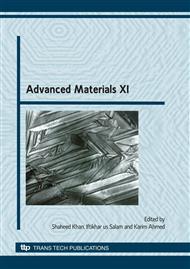p.309
p.316
p.322
p.330
p.335
p.342
p.349
p.356
p.364
Improvement in Mechanical Properties of High Concentration Particle Doped Thermoset Composites
Abstract:
The paper relates to high concentration particle doped composites based on thermosetting polymer systems in which the sequential addition of particles of certain size distribution is followed by curing and casting of the slurry to form a thermoset composite. Conventionally, at a threshold of beyond 90% of particles by weight of the polymer using triglyceride, the mechanical properties of the composite exhibit a sharp decline. The present research mitigates this behavior by incorporating a unique combination of cross-linking agents in the base polymer to impart exceptional mechanical properties to the composite. More specifically, the base polymer consists of butadiene, with triglyceride as cross-linking agent together with hydroxy-alkane as the chain extension precursors, when tune to the appropriate level of hard segment ratio in the polymer. An added advantage according to the present work resides in the analytical nature of butadiene pre-polymer as opposed to natural product; traditional composites based on natural sources are hampered by their inconsistent chemical composition and poor shelf life in the fabricated composite. The thermoset composite according the present research exhibits superior tensile strength (200-300 psi) properties using particle loading as high as 92% by weight of the fabricated composite as measured on a Tinius Olsen machine. Dynamic Mechanical Testing reveals interesting combination of storage and loss moduli in the fabricated specimens as a function of optimizing the thermal response of the viscoelastic composite to imposed vibration loading.
Info:
Periodical:
Pages:
335-341
Citation:
Online since:
June 2010
Authors:
Keywords:
Price:
Сopyright:
© 2010 Trans Tech Publications Ltd. All Rights Reserved
Share:
Citation:


